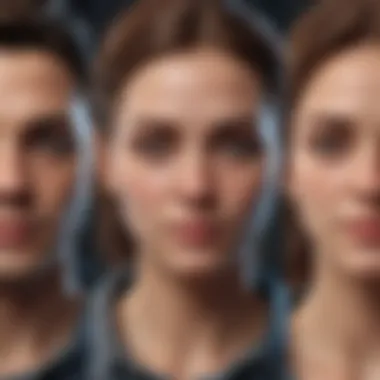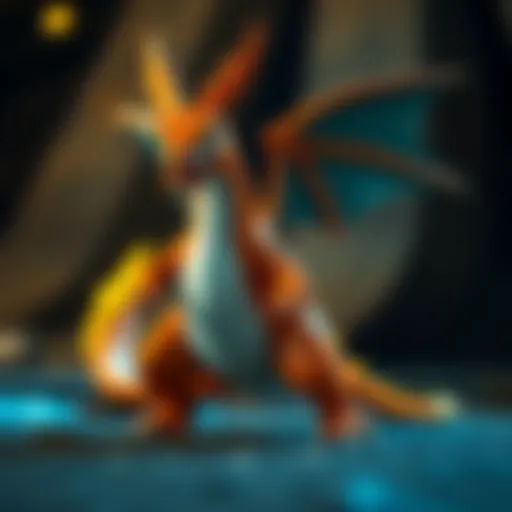Exploring the Depths of Gaming Character Makers


Intro
In today's gaming landscape, character creation tools hold significant sway. They serve as a canvas for players to paint their unique identities within virtual worlds. This article aims to guide you through the various facets of gaming character makers—not just their functions, but also their evolution and impact on storytelling and player engagement.
As games have grown more sophisticated, so too have the means by which players can create and customize their avatars. No longer are they mere avatars representing players; they are extensions of personality, encapsulating style, preferences, and even aspirations.
This narrative will explore the role these character makers play in recent titles and their implications for player experience. Let's dive into the intricacies that make these tools not just a feature, but an essential part of gaming culture.
Game Feature Spotlight
Unique Gameplay Mechanics
Character makers are more than just cosmetics; they often contribute significantly to gameplay. For example, in games like The Elder Scrolls V: Skyrim, players can create highly customized characters that influence gameplay styles. A character designed for stealth can have different mechanics than one geared towards brute force. This diversity breeds unique gameplay experiences where strategic decisions tie closely to character design, resulting in varied adventures.
Art Style and Design
From the pixelated charms of indie games to the stunning realism found in AAA titles, the art direction heavily influences character creation. Games like Fortnite adorn characters in wild, whimsical skins, while Dark Souls leans into a more grim aesthetic, allowing for gritty realism in design choices. The visual representation not only enhances the mood but can also dictate how players interact with the world around them.
Storyline and Characters
Customization can deeply enrich a game's narrative. Titles such as Mass Effect allow players to craft their characters while integrating their choices into the overarching story. The relationships built within the game can vary based on how a character is perceived by others, adding layers of depth not commonly found in linear storytelling. This interactivity is a driving force in modern gaming, providing players with a personalized narrative experience that can differ vastly from one to the next.
"Character makers do more than let players express individuality; they shape the stories we tell ourselves in games."
Through the different elements discussed in this section, it is evident that character makers are not merely cosmetic options but fundamental components that intricately weave into the fabric of gameplay, artistry, and narrative immersion.
Foreword to Gaming Character Makers
In today's gaming landscape, character makers stand as vital tools that allow players to mold their avatars according to personal tastes and preferences. This element of customization is not merely for aesthetic appeal; it has far-reaching implications for gameplay and narrative immersion. With players able to create characters that resonate with their identities or fantasies, these tools enhance the overall gaming experience. Character creation enables players to explore the narrative in ways that feel personal and engaging, often breathing life into stories that would otherwise remain flat.
Definition and Importance
Character makers can be defined as interactive systems within video games that allow users to design and modify characters. These systems typically provide a wide range of options, from physical attributes like height, build, and facial features to elements such as clothing choices and accessories. The significance of character makers lies in their ability to foster a deep sense of connection between the player and the game world. When players can shape their characters' looks and traits, it enhances player engagement and agency, making them feel more invested in the story.
For instance, in a role-playing game (RPG) such as Skyrim, players can spend hours adjusting every detail of their character's appearance. This level of personalization not only enhances the aesthetic experience but also encourages emotional investment in the character’s journey through the game.
Moreover, character makers can promote inclusivity. A diverse array of customization options enables players from different backgrounds to see themselves reflected in the game, bridging gaps of representation that have historically plagued the gaming industry.
Historical Context
The history of character makers is as varied as the games they inhabit. In earlier video games, character creation was often minimal or entirely absent, relying instead on fixed character avatars. Dungeons & Dragons, a game from the 1970s, laid foundational work for character customization, allowing players to create unique identities through stats and abilities. However, it wasn't until the advent of technology in the late 1990s that more complex character creators emerged.
Games like The Sims revolutionized how players interacted with their avatars. By allowing for detailed customization of appearance and personality traits, The Sims transformed the gaming narrative, enabling players to tell their own stories in ways never seen before. In the following years, more sophisticated character creators appeared in titles like World of Warcraft and Mass Effect, which further expanded the boundaries of player expression.
Today, character makers continue to evolve, with modern titles utilizing advanced graphics technology and user interfaces, providing players with an unprecedented level of detail and customization. As we explore this depth further, the significance of these tools cannot be overstated, as they greatly influence both individual player experiences and the gaming community at large.
Types of Character Makers
In today’s gaming landscape, the variety of character makers plays a pivotal role in shaping the player's experience. Understanding the different types can enhance player engagement and creativity, allowing individuals to truly immerse themselves in the games they love. From classic pixelated graphics to sophisticated 3D environments, each style has its own charm and utility. This section dives into the nuances of character creation, providing insights that can be beneficial not just for developers but for players who want to fully grasp what makes these character makers tick.
Pixelated vs. 3D Models
When it comes to character makers, a significant divide exists between pixelated models and their 3D counterparts. Both styles cater to different aesthetic preferences and gameplay experiences, each offering unique advantages.
Pixelated Models
Pixelated graphics hark back to the early days of video gaming, where developers had to be creative with limited resources. Using blocks of color to create characters not only evokes nostalgia but also simplifies the design process.
- Simplicity: Pixelated models are not overly complicated. This can make them easier to customize without overwhelming players.
- Artistic Style: There’s an unmistakable charm in pixels that appeals profoundly to many gamers, often associated with indie games.
- Accessibility: Lower system requirements mean players with less powerful hardware can still enjoy character design.
While pixelated models might not support intricate shading or lifelike movements, they shine in the context of creative expression. Think about games like Stardew Valley, where every pixel counts. Players adore creating characters that reflect their personalities with just a few choice pixels.
3D Models
In contrast, 3D character makers have become the industry standard, bringing a level of depth and realism that pixelated graphics cannot match.
- Realism: 3D models allow for more lifelike characters with nuanced animations, complex textures, and richer environments, presenting a more immersive experience.
- Customization Depth: Gamers have a wide array of options for adjusting attributes, from facial features to outfits. This level of detail can foster a deeper connection between the player and their avatar.
- Technical Advancements: As technology progresses, players expect high-quality graphics that make the gaming experience feel more engaging.
However, the complexity of 3D models can sometimes deter those who prefer a more straightforward approach to character creation. Titles such as The Sims illustrate the potential of 3D design, allowing players to explore diverse character options and experiment with lavish customization.
Text-Based Generators


Text-based character generators present a fascinating alternative to graphical models, tapping into the imagination and creativity of players. Rather than relying on images, these generators rely solely on text prompts to build characters, often in the context of role-playing games or storytelling.
- Imagination-Driven: Players create characters through their imagination, filling in the gaps themselves. This can lead to more unique and personalized avatars, as no two text generators need yield the same creation.
- Quick and Efficient: Attaining a character without fiddling with intricate visuals can save time for those eager to dive into gameplay.
- Accessibility for All: Text-based options are often easier for players with different abilities, as they can focus on the written word rather than navigating complex graphics.
Text-based generators offer a distinctive experience worth exploring. Games like Tabletop Simulator and various text-based RPGs showcase this style, where players develop characters purely through descriptive language, crafting tales that can soar far beyond what simple visuals might achieve.
Key Features of Character Makers
Character makers have come a long way in enhancing the player’s experience in video games. They serve as a platform for self-expression and creativity, allowing gamers to sculpt their digital avatars to their liking. This part of the article explores the key features that define character makers, focusing on customization options and user interface design. Understanding these elements is vital, as they can significantly impact player engagement and satisfaction.
Customization Options
Customization options are the bread and butter of any character maker. They provide players with the tools to mold their avatars, creating a connection that is often felt beyond the screen. Within customization, three major aspects stand out: physical attributes, clothing and accessories, and skills and abilities.
Physical Attributes
Physical attributes refer to how players can manipulate their character's appearance. This includes height, body type, hair color, and facial features. The ability to control these aspects not only promotes individuality but also helps players create characters that resonate with their personal identity. A key characteristic of physical attributes is the variety offered. Players enjoy experimenting, making characters that could represent them or someone entirely different. For example, some games allow the choice of unique ethnic features, promoting a sense of representation.
One drawback, however, is the potential for overwhelming complexities. If a game offers too many options, it might deter some players who prefer quick, intuitive choices. Therefore, the balance in offering sufficient options without sacrificing user experience is crucial.
Clothing and Accessories
Clothing and accessories provide flair and style to characters, enhancing visual appeal and personality. Players can choose outfits that reflect their liked fashion trends or thematic designs relevant to the game. This part of customization often becomes an avenue for storytelling. For instance, wearing a battle-worn armor implies a character’s tough history, while vibrant outfits can indicate a more playful narrative.
A popular aspect of clothing customization is the layering system available in various games. This enables players to mix and match different items for unique looks. However, not all titles implement this well. Some games may limit the options or merge outfits in ways that dilute the creative freedom that players cherish.
Skills and Abilities
Skills and abilities are another cornerstone of customization. They define a character’s strengths and weaknesses, influencing gameplay significantly. Players often relish the challenge of designing a character that suits their play style. Whether it’s a stealthy rogue or a magic-wielding hero, these choices shape the narrative arc and encounters within the game.
A mark of good skill customization is the depth it offers. Games like The Elder Scrolls V: Skyrim allow players to develop particular talents over time, creating a sense of long-term investment in that character. However, the complexity of this feature can be a double-edged sword; intricate skill trees might confuse new players, demanding more guidance in the game design.
User Interface Design
The user interface significantly influences how players interact with character makers. A friendly interface can make the character creation process feel more like a fun exploration rather than a tedious task. Two crucial aspects to examine include ease of use and accessibility.
Ease of Use
Ease of use refers to how intuitive the interface is during character creation. A well-designed interface allows users to navigate smoothly through customization options without feeling lost or frustrated. Key characteristics include clearly labeled menus and straightforward controls.
An interface that prioritizes ease of use can enhance player enjoyment. For example, games like Animal Crossing implement simple yet effective UI elements that cater to players of varying experience levels. But when ease is sacrificed for fancy graphics or overly complex designs, the satisfaction can quickly dwindle.
Accessibility
Accessibility deals with how well character makers accommodate players from different backgrounds and abilities. This includes options for color blindness, font sizes, and even support for players with physical disabilities. Having a diverse range of accessibility features is essential for inclusivity.
A notable advantage of focusing on accessibility is the expanded player base. When everyone can join in on the fun, the community grows stronger. But on the flip side, implementing comprehensive accessibility features can pose a significant development challenge. Striking a balance is essential for future advancements in character makers.
"In the world of gaming, character makers are not merely tools but portals through which players can explore their identities and story possibilities."
The Role of Character Development in Gameplay
Character development is like the backbone of any engaging video game. It’s not just about creating avatars that look cool; it’s about breathing life into them, letting the player forge their own narrative. A well-developed character can deeply influence the player's experience, shaping how they interact with the game's world and its inhabitants. This complexity is crucial since it allows players to feel that every choice they make counts.
Impact on Storytelling
When it comes to storytelling, character development does the heavy lifting. Think about iconic games like The Witcher 3 or Mass Effect. In these titles, players don’t just control their characters; they weave a story around them, influenced by their decisions. Each action taken can lead to different outcomes, creating a unique narrative for every playthrough.
- Personalized Experience: The player can mold their character’s backstory, which affects dialogue options and interactions. This creates a personalized narrative experience.
- Emotional Connection: Strong character development allows players to build emotional connections, which can enhance the gaming experience. When players care about their character, they become more invested in the storyline. This engagement can lead to a more immersive gaming session, where every twist and turn feels significant.
- Complex Narratives: Games with intricate character arcs often lead to more complex overarching narratives. By developing rich characters, storytellers can introduce subplots, moral dilemmas, and character growth that resonate with players on a deeper level.
"A character's journey can mirror the player's own, creating a rich tapestry of storytelling that captivates from the first moment to the last."
Player Agency and Immersion
Player agency refers to the sense of control and influence that players feel over their characters and the game world. This aspect of character development is vital; when players have agency, they are likely to feel more immersed in the game. Here are some elements that enhance this experience:
- Choice Matters: The more decisions players can make about their characters, the more they feel in control. Whether it’s deciding on moral choices or customizing verbal responses, these options grant players a stake in the game's outcome.
- World-Building Through Characters: The choices made during character creation often intertwine with the game’s lore. A thoughtful design can ensure that characters reflect the game world's culture, enhancing immersion.
- Real Consequences: Characters should grow or change based on the player’s actions. This brings a layer of realism to the gameplay. For instance, characters that react to player decisions create a living world that feels responsive and alive.
Ultimately, the role of character development in gameplay is pivotal. It influences how stories are told and felt, and governs how invested players can become. A well-crafted character not only shapes personal narratives but also invites players to explore the game's depths with genuine curiosity.
Notable Gaming Titles with Advanced Character Makers
Character makers play a pivotal role in defining not only the aesthetics of a game but also how players engage with the game's world. These tools have evolved remarkably, moving from rudimentary designs to intricate systems that allow for deep personalization. This section looks closely at games that excel in this area, emphasizing how they leverage character makers to enhance the gaming experience.


Role-Playing Games
In the realm of role-playing games (RPGs), character customization can make or break a player's connection to the story and the mechanics of the game. Titles like Skyrim and The Witcher 3: Wild Hunt have set benchmarks for character creators. Players can meticulously design their character’s physical attributes, from facial features to body builds, and even make choices that influence their skills and abilities.
What stands out in these games is the depth of choice offered in character creation. For instance, Divinity: Original Sin 2 allows players to choose not just the appearance but also the background story of their characters, which can affect interactions with NPCs. This means that the choices made at the character creation stage can lead to very different gameplay experiences, enhancing replayability. Players are not just observers; they are integral parts of the narrative, living out paths shaped by their creation choices.
Key Benefits of Character Makers in RPGs:
- Personal Identity: Players can create avatars that reflect their selves or their imagination, enhancing immersion.
- Narrative Flexibility: The ability to mold a character’s history fosters varied storytelling, leading to unique interactions.
- Gameplay Influence: Traits chosen during creation often influence game mechanics, enabling personalized strategies and approaches in quests.
Simulation Games
Simulation games like The Sims 4 transcend conventional character makers by allowing for elaborate societal simulations. These titles often focus on day-to-day interactions and life scenarios, thus requiring a high level of detail in character customization. The Sims franchise is well-known for its near limitless options in creating unique characters, from tweaking minute details to selecting personality traits that impact gameplay.
Animal Crossing: New Horizons also offers charm in character creation, emphasizing a more leisurely approach. While the options may appear simpler than in other RPGs, the design allows players to cultivate their in-game home and community, leading to deep engagement.
Features notable in Simulation Games:
- Customization Depth: Characters can be personalized almost to a fault, influencing the gameplay experience directly.
- Social Dynamics: The relationships formed within the game often hinge on character choices, which adds layers to gameplay.
- Diverse Experiences: Players are prompted to reflect on their choices, making the simulation feel personal and meaningful.
"The choice to craft your character is a leap beyond mere aesthetics; it provides players a canvas to explore their creativity and identity within a vast virtual realm."
User-Generated Content and Its Influence
User-generated content (UGC) has become a cornerstone in the evolution of gaming character makers. This trend exemplifies the shift from passive consumption to interactive engagement. For players, it’s not just about controlling a character; it’s about crafting one that mirrors their imagination. UGC empowers players by inviting them into the creative fold, resulting in a more personalized gaming experience. This has various benefits and considerations that developers must keep in mind.
One significant benefit of UGC in character makers is the enhancement of player investment. When players can create unique avatars that resonate with their personalities, they develop a deeper connection to the game. This investment can lead to longer play sessions and increased loyalty to the gaming franchise. Moreover, allowing players to share their creations can cultivate a sense of community. Players often take pride in their designs, showcasing them across social media platforms like Facebook and Reddit. Such visibility not only encourages creativity but also drives brand awareness.
However, UGC brings its fair share of considerations. Developers must ensure that the platforms for sharing creations are moderated to prevent harmful content from emerging. If left unchecked, inappropriate creations can tarnish the game’s reputation. Plus, finding a balance between allowing creative freedom and maintaining the integrity of the character design can be a tightrope walk. Striking that balance is essential so that the UGC complements the developer’s vision without overshadowing it.
In summary, the influence of user-generated content on gaming character makers is profound, as it cultivates community, expands player engagement, and solidifies loyalty. But it doesn’t come without its challenges. The onus is on developers to navigate these waters thoughtfully while leveraging the creative potential of their player base.
"Character makers are more than tools; they're gateways to personal expression in gaming."
Community Creations
Community creations are a vibrant manifestation of player creativity. When players share their character designs, they contribute to a larger tapestry that reflects the diverse cultures and ideas within the gaming world. Every creation tells a story, whether it’s a warrior inspired by mythology or a whimsical creature born from pure imagination. The benefit here is twofold: not only do players engage with the game environment more deeply, but they also inspire others in the community.
Often, community creations can lead to unofficial contests. These contests encourage players to push their creative limits while offering recognition and rewards. Such grassroots creativity not only enriches the game’s visual landscape but also fosters camaraderie among players. The act of showcasing one's work can create a rush akin to standing before a gallery of art.
Modding Culture
Modding culture intertwines seamlessly with user-generated content, especially in character makers. Mods, which are modifications made by players, extend far beyond simple reskins of characters; they can introduce entirely new gameplay elements or drastically alter the way characters are perceived. For instance, a popular RPG may allow a modder to create new character classes, abilities, or even entire story arcs.
The significance of modding culture lies in its transformative power. Players are no longer just recipients of a narrative but are actively shaping it. This participatory experience not only enhances the depth of gameplay but can lead to innovations that the original developers may not have considered. However, this culture also raises important questions about intellectual property and credit. It’s crucial for developers to support modding communities while ensuring that original content owners are acknowledged.
Through community creations and modding culture, user-generated content shapes the gaming landscape. It's about embracing creativity and encouraging players to redefine their experiences altogether. The ability to custom mold characters fosters a collective identity within the game, making every player’s journey unique.
Challenges in Character Maker Design
The design of gaming character makers presents a unique set of challenges that are critical in shaping the overall success of any game. Balancing intricacies of customization with user experience is a delicate dance that developers must perform. Poor design can lead to frustration among players, while a well-designed character maker can enrich the gaming experience tremendously.
A key part of this challenge lies in understanding the user’s needs without losing sight of the technological constraints. Character makers should ideally strike a balance between empowering players with choices and keeping the process engaging without being overwhelming. Different players have diverse expectations; some prefer a simplified option while others desire an exhaustive set of features to create a character that resonates with their vision. Achieving this balance not only enhances player satisfaction but also impacts retention rates in a competitive market.
Balancing Complexity and Usability
To illustrate, consider a character maker that includes a myriad of options: different ethnicities, body types, facial features, and outfits. While on the surface this depth seems exciting, it can quickly become a maze for players. They may feel lost in choices, leading to decision fatigue. Players often seek immediate gratification—immersing themselves in gameplay rather than spending excessive time tweaking their characters.
Some approaches to addressing this include:
- Streamlined Interfaces: Utilize a clean layout that emphasizes the most vital options and groups related features together.
- Progressive Disclosure: Introduce more complex options gradually as the player grows comfortable with the basics.
- Preview Tools: Offering players a clear preview of their character can clarify how choices influence the character's appearance and capabilities.
Balancing complexity and usability requires constant feedback from the player base to fine-tune the interface and features. Incorporating regular updates based on user experience can help keep the character maker relevant and user-friendly, assisting in tailoring gameplay accordingly.
Technical Limitations
Even with the best design principles, technical constraints can hamper the potential of character makers. Depending on the platform—be it a console, PC, or mobile device—these limitations can vary significantly.
- Performance Issues: Excessive detail in character customization can lead to performance dips. High-resolution models and textures may cause lag or unresponsive gameplay, especially in high-action settings.
- Rendering Capabilities: The complexity of rendering 3D characters varies across devices. Older hardware may struggle with advanced visual customization, affecting usability on some platforms.
- File Size Constraints: Larger character models can bloat the file size of the game itself, which may alienate users with limited storage. Developers often need to find a sweet spot to maintain quality without excessively enlarging the game size.
Keeping these limitations in check is crucial. Addressing them often requires innovative solutions, like adaptive graphics that adjust according to the player's hardware capabilities, or limiting customization options on less powerful platforms while focusing on more in-depth options for high-end users.


The essence of successful character maker design is understanding that every choice made must enhance the player's experience, not cloud it.
Addressing these challenges is not just about overcoming technical barriers; it’s about creating a richer, more immersive player experience. As technology progresses, so too will the capabilities of character makers, and the horizon looks bright, albeit with its fair share of hurdles to leap.
Future Trends in Character Making Technology
The landscape of gaming character makers is poised for seismic shifts thanks to emerging technologies that are redefining how players create and experience their in-game personas. As the horizon expands, innovations such as artificial intelligence and virtual reality stand to enhance both the depth of customization and the engagement levels for players. Understanding these future trends is of prime importance; they not only shape individual gaming experiences but also influence community interactions and storytelling techniques.
Artificial Intelligence Integration
Artificial intelligence is no longer just a buzzword—it's actively infiltrating the gaming world, particularly in character creation. With AI, character makers can learn player preferences over time, delivering tailored suggestions that make customization feel personal and intuitive. For instance, imagine designing a hero with an algorithm that analyzes existing styles and trends, presenting players with options that might’ve otherwise been overlooked.
Consider how AI could streamline complex decisions such as class determination or visual aesthetics. Instead of merely providing a list of options, an AI system can analyze the player's previous choices and propose a selection finely tuned to their tastes.
Moreover, AI-driven tools could facilitate more nuanced emotional connections by adapting the character's backstory or behaviors to complement the player's choices within the game. By leveraging natural language processing, games like Black Desert Online and The Sims could feature chatbots that help players navigate through the often-layered customization processes.
The use of AI also aids in dynamic contextualization. For example, if a player often selects heroic traits, the system could begin recommending traits that augment heroism, enhancing the overall experience and promoting player engagement.
Virtual Reality Enhancements
Virtual reality is at the forefront of revolutionizing how we engage with game content. Imagine stepping into a digital world where you craft your character not just through mouse clicks, but in immersive environments that respond to your every movement. VR poses the ability for players to utilize hand gestures to manipulate character features—players can sculpt facial features or select outfits as if they were molding clay.
This kind of engagement deepens the player's investment in their creation. The tactile experience associated with VR can lead to a stronger emotional attachment to characters, as each transformation becomes a physical act rather than an abstract selection.
Additionally, as VR technology continues to evolve, features like collaborative character making can emerge. Imagine a scenario where multiple players enter a shared virtual space to design a character together—discussing, debating, and combining their visions. Such a communal aspect could introduce rich interactions, elevating not only trust but also friendships forged within these virtual realms.
"Virtual reality opens the door for players to interact with their characters on a fundamentally different level, creating bonds that traditional screens simply can't replicate."
As these technologies carve their paths forward, considerations arise too—accessibility, costs, and the need for players to possess powerful hardware. Balancing innovation with user experience will undoubtedly dictate the success of these advancements. The next wave of character creators will morph into confluence zones, merging technical prowess and artistry with player imagination.
Ethics and Representation in Character Customization
In an era where gaming has transcended mere entertainment and become a medium for storytelling, expression, and community, the ethics surrounding character customization have gained paramount importance. The choices players make during character creation carry weight; they mirror personal identities, societal values, and cultural nuances. Gaming developers must tread carefully, embracing the responsibility that comes with crafting these digital personas. Fostering respectful representation not only enhances the user experience but is also crucial in building a more inclusive gaming community.
Cultural Sensitivity
Cultural sensitivity in character customization calls attention to the complexity of diverse identities and traditions. When players design characters, they often pull from personal experiences, folklore, or cultural backgrounds. This blending enriches the gameplay but risks misappropriation without thoughtful implementation.
For instance, a fantasy game might allow players to draw inspiration from various mythologies around the globe, but developers need to ensure that they don’t reduce those cultures to stereotypes or caricatures. A prime example lies in the portrayal of indigenous peoples, often seen through a narrow lens. Incorporating authentic cultural elements requires collaboration with cultural consultants and communities to ensure accurate representation.
The implications of neglecting cultural sensitivity can have resonating effects. Misrepresentation can lead to backlash, communities feeling alienated, and a tarnished reputation for the game itself. When developers show awareness and respect for the source materials, it not only benefits the narratives but cultivates goodwill among players, further deepening their connection to the game. A win-win, if you will.
Inclusivity in Design
Inclusivity in character design is more than just a buzzword; it's a critical benchmark for the gaming industry. When creators adopt inclusive strategies, they cultivate environments where all players feel seen and valued. Drafting characters that encompass a variety of identities—such as race, gender, abilities, and body types—results in a richer experience for everyone involved.
Many games today provide a range of customization options that break traditional molds of character representation. Games such as The Sims allow users to create characters with a wide spectrum of sizes, abilities, and features, making it easier for players to project themselves onto their avatars. In a world where representation matters, every choice in design communicates to players who they are and what they can become.
Here are some key points to consider regarding inclusivity in character design:
- Diverse Representation: Ensuring characters reflect the diverse population of players.
- Customizable Abilities: Addressing both visible and invisible disabilities through gameplay mechanics.
- Gender Fluidity: Allowing players to define their characters outside binary gender norms, giving them the freedom to choose.
"Inclusivity in game design isn't just a checkbox; it's the engine that drives player engagement and connection."
Bringing inclusivity into character makers not only empowers players but also enriches the gaming community by promoting understanding and acceptance. As gaming evolves, so too must the tools we provide for players to express who they truly are, fostering a landscape where everyone can thrive.
Epilogue: The Significance of Character Makers
In the realm of modern gaming, character makers stand as a cornerstone of player experience and engagement. They do not merely facilitate the creation of avatars; they foster a deeper connection between gamers and their chosen virtual personas. Through versatility in customization, character makers allow players to portray identities that resonate with their personal experiences or aspirations. This element of self-expression elevates gaming from being a passive activity to an interactive and engaging experience.
Transforming Player Experience
Character makers change the way players engage with the game in profound ways. First off, they provide a unique canvas, enabling players to envision themselves within fantastical worlds. This reflection of self can manifest in various forms—from the physical traits of the avatar to the intricate backstory forged by the player. When a player creates a character that feels personal, they naturally invest more emotional energy into the gameplay.
Moreover, the customization options often transcend physical attributes. Players can choose skills, abilities, and even moral alignments, which consequently influence narrative outcomes. This variety propels players into an active role in the storytelling process. For instance, in The Elder Scrolls V: Skyrim, players can create anything from a brooding assassin to a benevolent mage, each choice impacting their journey through the expansive game world.
This array of choices also cultivates a sense of ownership. The more unique a character that a player has crafted, the more they feel a connection to it, making every triumph and defeat more impactful.
Future Directions for Developers
Moving forward, the landscape of character makers is ripe with potential for innovation. As technology develops, we can expect developers to incorporate advanced elements like machine learning. This could lead to adaptive character creation systems that learn player preferences over time. Imagine a character maker that proposes unique traits based on past selections or gameplay style—this level of personalization could set new benchmarks in gaming.
Additionally, there’s an increasing emphasis on inclusivity. Future character makers may offer even more extensive options to represent diverse backgrounds, genders, and abilities, ensuring that every player can find a reflection of themselves in the avatars they create.
Finally, as virtual reality technology becomes more mainstream, character makers must evolve to accommodate immersive experiences. The fluidity in character manipulation stands to enhance the realism of gameplay further. In a virtual setting, every movement and gesture by the avatar crafted through character makers could be replicated, heightening player engagement.
"Ultimately, the evolution of technology will reshape how we see and interact with characters in games, making the role of character makers more pivotal than ever."
With advancements on the horizon, developers have an exciting opportunity to enrich gaming culture through thoughtful character maker design. It is imperative that they embrace these challenges, allowing players not just to create characters but to weave their own narratives within the gaming tapestry.







